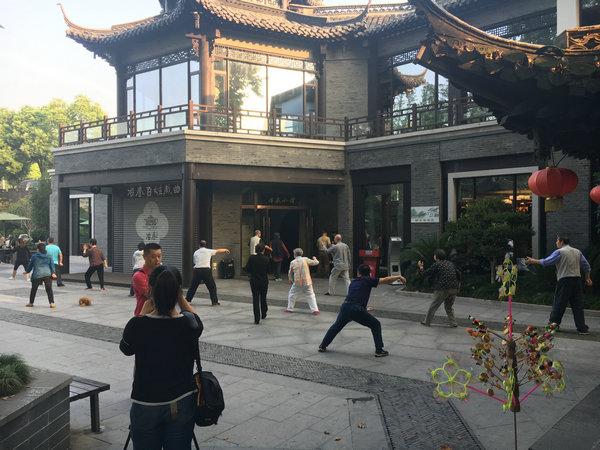
From the People's Daily app.
And this is Story in the Story.
The historical city of Yangzhou, Jiangsu Province, has more than 2,500 years of history, and has become a hotspot for tourists from around China and abroad.
One of its more noteworthy attractions is the Lianghuai Salt Transport Museum in Shi'er Xu Ancient Town, Yizheng, a county-level city of Yangzhou, opened to the public in March.
The museum, built in the style of the Ming and Qing Dynasties (1368-1911), houses more than 600 exhibits, some of which are provided by the China Salt Association.
During the reign of Emperor Tongzhi of the Qing Dynasty (1861-1875), Shi'er Xu became the largest distribution center of the salt industry in the Lianghuai district (regions along the Huaihe River). One third of the salt transported to the whole nation came from the district.
The museum is divided into four exhibition halls and has various types of exhibitions which vividly depict the history of the Lianghuai salt industry. But there is much more to the city, and its administrators hope their plans to promote it will pay dividends.
Today's Story in the Story looks at how Yangzhou is combining its rich cultural history with modern day tourism.
Yangzhou is a hotspot for tourists from home and abroad.
Yangzhou is reputed to have once been one of the wealthiest cities in all of China. Today it has a population of 4.4 million.
To better service tourists in 2019, 10 suggestions were released by Yangzhou Municipal Committee and Yangzhou Municipal Government in February to promote the positioning of Yangzhou as an international cultural and tourism city.
One of the first things on their to-do list was to improve services for tourists during national holidays, namely Tomb Sweeping Day, Labor Day and National Day.
Temporary free parking lots will be set up in the city during holidays, and people from other cities can take buses to the downtown area for free with valid identity cards. As well, the city will open more parking lots around government buildings.
City administrators also want to promote Yangzhou delicacies. That includes establishing two tasting centers for Huaiyang cuisine and five story-telling houses featuring Huaiyang delicacies.
Free entrance to key scenic areas is another move to lure tourists. The region has an abundance of scenic areas such as Slender West Lake, Daming Temple, Ge Garden, He Garden and Yangzhou Museum of Guangling King's Tomb in the Han Dynasty and Eight Yangzhou Eccentrics Memorial.
Free shuttle buses traveling among major scenic areas will be put into use in April, May, September and October.
The service functions of Yangzhou Port will be improved to offer better services to passengers on cruises that dock at Yangzhou Port.
Public facilities such as guideboards, bus stops, parking lots and city parks are being renovated into tourism-friendly places, catering to the needs of inbound tourists.

Elderly men and women practice tai chi in the early morning at an open area in front of Ye Chun Teahouse, a popular eatery in Yangzhou. (Photo: China Daily)
Zaocha is something unique to Yangzhou. It is an early-morning meal where delicious small treats are served with a variety of steaming hot teas.
It might sound similar to any other breakfast ritual that takes place throughout the world, but it’s not. Zaocha in Yangzhou is a traditional, cultural and overwhelmingly social event.
Another local attraction is the popular Ye Chun Teahouse.
Ye Chun was first established in 1877 as a place for Yangzhou locals to enjoy good tea and good food. Over the years the restaurant has become synonymous with zaocha, with people lining up in the early hours to get a table so they can enjoy the food, the hot tea and most importantly a good chat with friends.
Examples of the cuisine served there include tanggansi, or shredded tofu in soup, sandingbao, or three-diced bun and xiehuang tangbao, or crab-roe soup dumpling.
Yangzhou also has a cultural history. In ancient times the city was called Guangling. That name lends itself to Guangling San, or the Guangling Melody, which is said to be one of the 10 greatest classic guqin compositions. The guqin is a seven-stringed Chinese instrument.
Although the origins of Guangling San, the authenticity of its tablature, and the relationship between the piece and Yangzhou continue to be debated among academics, it is widely accepted that the piece was once circulated in the Yangzhou region, underlining a historical connection between Yangzhou and guqin culture.
Yangzhou continues to be home to China's most well-known guqin masters, one being Ma Weiheng, regarded by many as an unofficial ambassador of the Yangzhou region.
"The Guangling School of guqin is closely related to Yangzhou's culture, from food and garden, to language and literature," Ma says.
The Yangzhou Municipal Committee and Yangzhou Municipal Government hope their efforts to offer benefits to visitors will encourage tourists to consider Yangzhou as a destination.
(Produced by Nancy Yan Xu, Brian Lowe, Lance Crayon and Da Hang. Music by: bensound.com. Text from China Daily and Global Times.)


